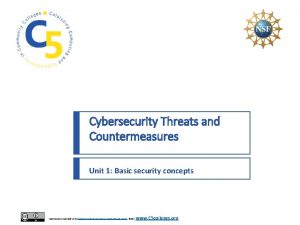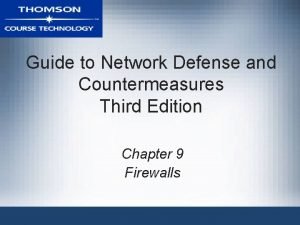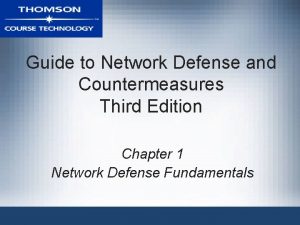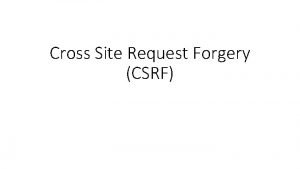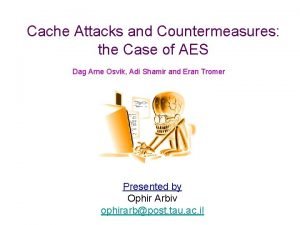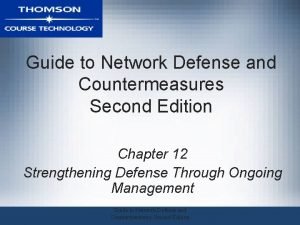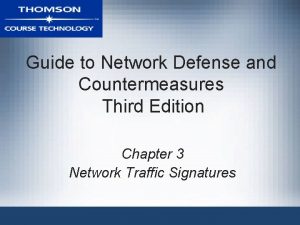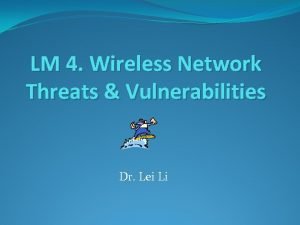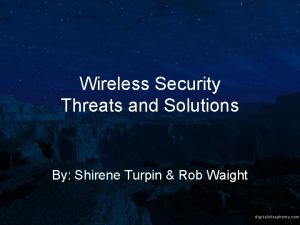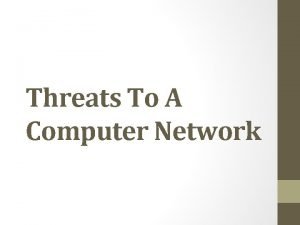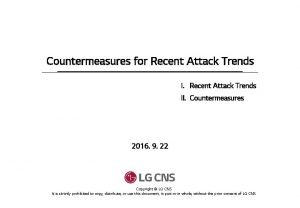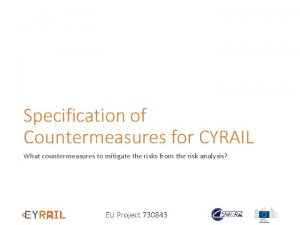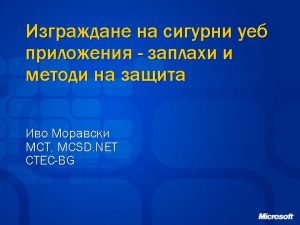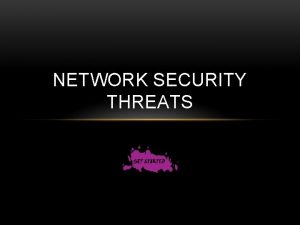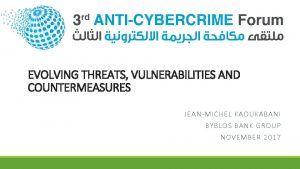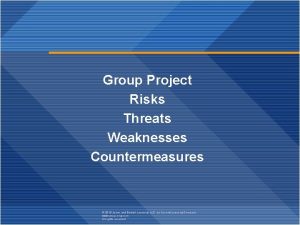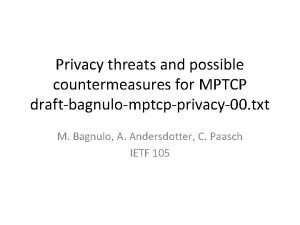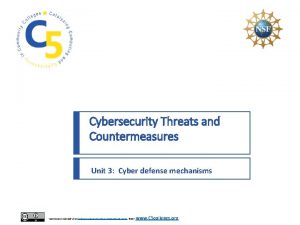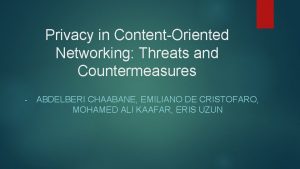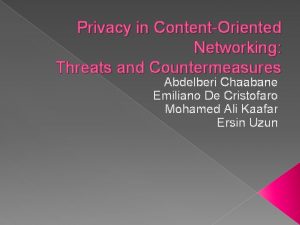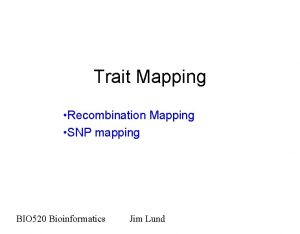Internet security threats Countermeasures Internet security threats Mapping
















- Slides: 16

Internet security threats Countermeasures

Internet security threats Mapping: – before attacking: “case the joint” – find out what services are implemented on network – Use ping to determine what hosts have addresses on network – Port-scanning: try to establish TCP connection to each port in sequence (see what happens) – nmap (http: //www. insecure. org/nmap/) mapper: “network exploration and security auditing” Countermeasures?

Internet security threats Mapping: countermeasures – record traffic entering network – look for suspicious activity (IP addresses, pots being scanned sequentially)

Internet security threats Packet sniffing: – – broadcast media promiscuous NIC reads all packets passing by can read all unencrypted data (e. g. passwords) e. g. : C sniffs B’s packets C A src: B dest: A Countermeasures? payload B

Internet security threats Packet sniffing: countermeasures – all hosts in organization run software that checks periodically if host interface is in promiscuous mode. – one host per segment of broadcast media (switched Ethernet at hub) C A src: B dest: A payload B

Internet security threats IP Spoofing: – can generate “raw” IP packets directly from application, putting any value into IP source address field – receiver can’t tell if source is spoofed – e. g. : C pretends to be B C A src: B dest: A Countermeasures? payload B

Internet security threats IP Spoofing: ingress filtering – routers should not forward outgoing packets with invalid source addresses (e. g. , datagram source address not in router’s network) – great, but ingress filtering can not be mandated for all networks C A src: B dest: A payload B

Internet security threats Denial of service (DOS): – flood of maliciously generated packets “swamp” receiver – Distributed DOS (DDOS): multiple coordinated sources swamp receiver – e. g. , C and remote host SYN-attack A C A SYN SYN SYN B Countermeasures? SYN

Internet security threats Denial of service (DOS): countermeasures – filter out flooded packets (e. g. , SYN) before reaching host: throw out good with bad – traceback to source of floods (most likely an innocent, compromised machine) C A SYN SYN SYN B SYN

DNS Spoofing • Tricking a DNS server into installing a false IP address is called DNS spoofing • A cache that holds an intentionally false IP address is called a poisoned cache

Secure Naming - DNS Spoofing • (a) Normal situation. (b) An attack based on breaking into DNS and modifying Bob's record.

Secure Naming (2) - DNS Spoofing • How Trudy spoofs Alice's ISP.

Secure DNS • Based on public key cryptography, • Every DNS zone has a public/private key pair • All information sent by a DNS server is signed with the originating zone’s private key, so the receiver can verify its authenticity • DNSsec offers three fundamental services: - Proof of where data originated, - Public Key Distribution - Transaction and request authentication Not yet implemented everywhere

Secure DNS • DNSsec records are grouped into RRSets (Resource Record Sets), with all the records having the same name, class and type and which may contain multiple A records • New records types - KEY (public key of the zone, user, host, or other principal, the algorithm used for signing, the protocol used for transmission etc), - SIG (signed hash using algorithm specified in the KEY),

Secure DNS An example RRSet for bob. com. The KEY record is Bob's public key. The SIG record is the top-level com server's signed hash of the A and KEY records to verify their authenticity.

Secure DNS • Alice asks DNS for the RRSet of bob. com – she gets among others Bob’s public key; • Then she asks Bob’s DNS server for the IP address of the Bob’s web page; She can verify it because it is signed with Bob’s private key; If Trudy injected a false RRSet into any cache, its lack of authenticity will easily be detected; DNS may (optionally) use cryptography to bind a response to a specific query to prevent spoofing.
 Cyber security threats and countermeasures
Cyber security threats and countermeasures Guide to network defense and countermeasures
Guide to network defense and countermeasures Guide to network defense and countermeasures
Guide to network defense and countermeasures Csrf countermeasures
Csrf countermeasures Cache attacks and countermeasures: the case of aes
Cache attacks and countermeasures: the case of aes Spill prevention control & countermeasures training
Spill prevention control & countermeasures training Operational auditing
Operational auditing Whirshark
Whirshark Memory parameters
Memory parameters Forward mapping vs backward mapping
Forward mapping vs backward mapping Terjemahan
Terjemahan Wireless security threats and vulnerabilities
Wireless security threats and vulnerabilities Modern network security
Modern network security Communication channel threats
Communication channel threats Wireless security threats
Wireless security threats Common computer threats
Common computer threats Private secuirty
Private secuirty
